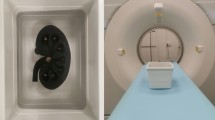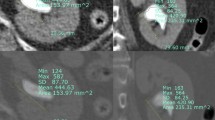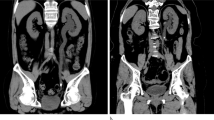Key Points
-
Noncontrast CT is the most accurate imaging modality for kidney stones owing to high sensitivity, specificity, accurate stone sizing, and the ability to evaluate non-stone-related pathologies
-
Ultrasonography has a lower sensitivity and specificity than CT, but does not expose patients to ionizing radiation and is less expensive than CT
-
Ultrasonography has several limitations, but a randomized controlled trial demonstrated similar performance in the emergency department to that of CT for patients with suspected kidney stones
-
Ultrasonography is the first-line imaging modality for pregnant women and patients <14 years old
-
Low-dose CT has many of the same advantages of standard CT and reduces radiation exposure; however, its diagnostic accuracy is reduced in obese patients and dose modulation should be considered
-
In the future, improvements in CT, ultrasonography, kidney ureter bladder radiography, and MRI might improve the accuracy of imaging kidney stones
Abstract
Kidney stone imaging is an important diagnostic tool and initial step in deciding which therapeutic options to use for the management of kidney stones. Guidelines provided by the American College of Radiology, American Urological Association, and European Association of Urology differ regarding the optimal initial imaging modality to use to evaluate patients with suspected obstructive nephrolithiasis. Noncontrast CT of the abdomen and pelvis consistently provides the most accurate diagnosis but also exposes patients to ionizing radiation. Traditionally, ultrasonography has a lower sensitivity and specificity than CT, but does not require use of radiation. However, when these imaging modalities were compared in a randomized controlled trial they were found to have equivalent diagnostic accuracy within the emergency department. Both modalities have advantages and disadvantages. Kidney, ureter, bladder (KUB) plain film radiography is most helpful in evaluating for interval stone growth in patients with known stone disease, and is less useful in the setting of acute stones. MRI provides the possibility of 3D imaging without exposure to radiation, but it is costly and currently stones are difficult to visualize. Further developments are expected to enhance each imaging modality for the evaluation and treatment of kidney stones in the near future. A proposed algorithm for imaging patients with acute stones in light of the current guidelines and a randomized controlled trial could aid clinicians.
This is a preview of subscription content, access via your institution
Access options
Subscribe to this journal
Receive 12 print issues and online access
$209.00 per year
only $17.42 per issue
Buy this article
- Purchase on Springer Link
- Instant access to full article PDF
Prices may be subject to local taxes which are calculated during checkout






Similar content being viewed by others
References
Scales, C. D. et al. Prevalence of kidney stones in the United States. Eur. Urol. 62, 160–165 (2012).
Stamatelou, K. K., Francis, M. E., Jones, C. A., Nyberg, L. M. & Curhan, G. C. Time trends in reported prevalence of kidney stones in the United States: 1976–1994. Kidney Int. 63, 1817–1823 (2003).
Fwu, C. W., Eggers, P. W., Kimmel, P. L., Kusek, J. W. & Kirkali, Z. Emergency department visits, use of imaging, and drugs for urolithiasis have increased in the United States. Kidney Int. 83, 479–486 (2013).
Preminger, G. M. et al. 2007 guideline for the management of ureteral calculi. J. Urol. 178, 2418–2434 (2007).
Scales, C. D. Jr et al. Urinary stone disease: advancing knowledge, patient care, and population health. Clin. J. Am. Soc. Nephrol. 11, 1305–1312 (2016).
Smith-Bindman, R. et al. Ultrasonography versus computed tomography for suspected nephrolithiasis. N. Engl. J. Med. 371, 1100–1110 (2014).
Miller, N. L., Evan, A. P. & Lingeman, J. E. Pathogenesis of renal calculi. Urol. Clin. North Am. 34, 295–313 (2007).
Hammad, F. T., Lammers, W. J., Stephen, B. & Lubbad, L. Propagation of the electrical impulse in reversible unilateral ureteral obstruction as determined at high electrophysiological resolution. J. Urol. 185, 744–750 (2011).
Ordon, M., Schuler, T. D., Ghiculete, D., Pace, K. T. & Honey, R. J. Stones lodge at three sites of anatomic narrowing in the ureter: clinical fact or fiction? J. Endourol. 27, 270–276 (2013).
Fielding, J. R., Silverman, S. G., Samuel, S., Zou, K. H. & Loughlin, K. R. Unenhanced helical CT of ureteral stones: a replacement for excretory urography in planning treatment. AJR Am. J. Roentgenol. 171, 1051–1053 (1998).
Coll, D. M., Varanelli, M. J. & Smith, R. C. Relationship of spontaneous passage of ureteral calculi to stone size and location as revealed by unenhanced helical CT. AJR Am. J. Roentgenol. 178, 101–103 (2002).
Coursey, C. A. et al. ACR Appropriateness Criteria(R) acute onset flank pain—suspicion of stone disease. Ultrasound Q. 28, 227–233 (2012).
Memarsadeghi, M. et al. Unenhanced multi-detector row CT in patients suspected of having urinary stone disease: effect of section width on diagnosis. Radiology 235, 530–536 (2005).
Schwartz, B. F., Schenkman, N., Armenakas, N. A. & Stoller, M. L. Imaging characteristics of indinavir calculi. J. Urol. 161, 1085–1087 (1999).
Nakada, S. Y. et al. Determination of stone composition by noncontrast spiral computed tomography in the clinical setting. Urology 55, 816–819 (2000).
Shah, K. et al. Predicting effectiveness of extracorporeal shockwave lithotripsy by stone attenuation value. J. Endourol. 24, 1169–1173 (2010).
Kim, S. C. et al. Cystine calculi: correlation of CT-visible structure, CT number, and stone morphology with fragmentation by shock wave lithotripsy. Urol. Res. 35, 319–324 (2007).
Duan, X. et al. Differentiation of calcium oxalate monohydrate and calcium oxalate dihydrate stones using quantitative morphological information from micro-computerized and clinical computerized tomography. J. Urol. 189, 2350–2356 (2013).
Primak, A. N. et al. Noninvasive differentiation of uric acid versus non-uric acid kidney stones using dual-energy CT. Acad. Radiol. 14, 1441–1447 (2007).
Qu, M. et al. Dual-energy dual-source CT with additional spectral filtration can improve the differentiation of non-uric acid renal stones: an ex vivo phantom study. AJR Am. J. Roentgenol. 196, 1279–1287 (2011).
Wang, J. et al. Characterisation of urinary stones in the presence of iodinated contrast medium using dual-energy CT: a phantom study. Eur. Radiol. 22, 2589–2596 (2012).
Coursey, C. A. et al. Dual-energy multidetector CT: how does it work, what can it tell us, and when can we use it in abdominopelvic imaging? Radiographics 30, 1037–1055 (2010).
Vujovic, A. & Keoghane, S. Management of renal stone disease in obese patients. Nat. Clin. Pract. Urol. 4, 671–676 (2007).
Neitlich, T. & Neitlich, J. The imaging evaluation of cholelithiasis in the obese patient-ultrasound versus CT cholecystography: our experience with the bariatric surgery population. Obes. Surg. 19, 207–210 (2009).
Fulgham, P. F., Assimos, D. G., Pearle, M. S. & Preminger, G. M. Clinical effectiveness protocols for imaging in the management of ureteral calculous disease: AUA technology assessment. J. Urol. 189, 1203–1213 (2013).
Türk, C. et al. EAU guidelines on interventional treatment for urolithiasis. Eur. Urol. 69, 475–482 (2015).
Blacklock, N. J. The pattern of urolithiasis in the Royal Navy. J. R. Nav. Med. Serv. 51, 99–111 (1965).
National Research Council. Health Risks from Exposure to Low Levels of Ionizing Radiation: BEIR VII, Phase I, Letter Report (The National Acadamies Press, 1998).
Brenner, D. J. & Hall, E. J. Computed tomography — an increasing source of radiation exposure. N. Engl. J. Med. 357, 2277–2284 (2007).
Jellison, F. C. et al. Effect of low dose radiation computerized tomography protocols on distal ureteral calculus detection. J. Urol. 182, 2762–2767 (2009).
Niemann, T., Kollmann, T. & Bongartz, G. Diagnostic performance of low-dose CT for the detection of urolithiasis: a meta-analysis. AJR Am. J. Roentgenol. 191, 396–401 (2008).
Alsyouf, M. et al. Comparing stone attenuation in low- and conventional-dose noncontrast computed tomography. J. Endourol. 28, 704–707 (2014).
Poletti, P. A. et al. Low-dose versus standard-dose CT protocol in patients with clinically suspected renal colic. AJR Am. J. Roentgenol. 188, 927–933 (2007).
Gervaise, A. et al. Low-dose CT with automatic tube current modulation, adaptive statistical iterative reconstruction, and low tube voltage for the diagnosis of renal colic: impact of body mass index. AJR Am. J. Roentgenol. 202, 553–560 (2014).
Erwin, B. C., Carroll, B. A. & Sommer, F. G. Renal colic: the role of ultrasound in initial evaluation. Radiology 152, 147–150 (1984).
Asrat, T., Roossin, M. C. & Miller, E. I. Ultrasonographic detection of ureteral jets in normal pregnancy. Am. J. Obstet. Gynecol. 178, 1194–1198 (1998).
Ray, A. A., Ghiculete, D., Pace, K. T. & Honey, R. J. Limitations to ultrasound in the detection and measurement of urinary tract calculi. Urology 76, 295–300 (2010).
Melnikow, J. et al. Cost analysis of the STONE randomized trial: can health care costs be reduced one test at a time? Med. Care 54, 337–342 (2016).
Patel, S. J., Reede, D. L., Katz, D. S., Subramaniam, R. & Amorosa, J. K. Imaging the pregnant patient for nonobstetric conditions: algorithms and radiation dose considerations. Radiographics 27, 1705–1722 (2007).
Dunmire, B. et al. Use of the acoustic shadow width to determine kidney stone size with ultrasound. J. Urol. 195, 171–177 (2016).
Sorensen, M. D. et al. B-mode ultrasound versus color Doppler twinkling artifact in detecting kidney stones. J. Endourol. 27, 149–153 (2013).
Cunitz, B. et al. Improved detection of kidney stones using an optimized doppler imaging sequence. IEEE Int. Ultrason. Symp. 2014, 452–455 (2014).
Sapozhnikov, O., Lu, W., Bailey, M. R., Kaczkowski, P. & Crum, L. A. 2aBA6 Bubbles trapped on the surface of kidney stones as a cause of the twinkling artifact in ultrasound imaging. Proc. Meet. Acoust. 19, 075033 (2013).
Dunmire, B. et al. Tools to improve the accuracy of kidney stone sizing with ultrasound. J. Endourol. 29, 147–152 (2015).
Khokhlova, T., Li, T., Sapozhnikov, O. & Hwang, J. H. The use of twinkling artifact of Doppler imaging to monitor cavitation in tissue during high intensity focused ultrasound therapy. Proc. Meet. Acoust 19, 075034 (2013).
Sorensen, M. D. et al. Focused ultrasonic propulsion of kidney stones: review and update of preclinical technology. J. Endourol. 27, 1183–1186 (2013).
Sanders, J. L., Noble, V. E., Raja, A. S., Sullivan, A. F. & Camargo, C. A. Jr. Access to and use of point-of- care ultrasound in the emergency department. West J. Emerg. Med. 16, 747–752 (2015).
Talley, B. E. et al. Variable access to immediate bedside ultrasound in the emergency department. West J. Emerg. Med. 12, 96–99 (2011).
Worster, A., Preyra, I., Weaver, B. & Haines, T. The accuracy of noncontrast helical computed tomography versus intravenous pyelography in the diagnosis of suspected acute urolithiasis: a meta-analysis. Ann. Emerg. Med. 40, 280–286 (2002).
Thomson, J. M., Glocer, J., Abbott, C., Maling, T. M. & Mark, S. Computed tomography versus intravenous urography in diagnosis of acute flank pain from urolithiasis: a randomized study comparing imaging costs and radiation dose. Australas. Radiol. 45, 291–297 (2001).
Johnston, R., Lin, A., Du, J. & Mark, S. Comparison of kidney-ureter-bladder abdominal radiography and computed tomography scout films for identifying renal calculi. BJU Int. 104, 670–673 (2009).
Ege, G., Akman, H., Kuzucu, K. & Yildiz, S. Can computed tomography scout radiography replace plain film in the evaluation of patients with acute urinary tract colic? Acta Radiol. 45, 469–473 (2004).
Bishoff, J. T. & Rastinehad, A. R. in Campbell-Walsh Urology Vol. 1. Ch. 2 (eds Wein, A. J., Kavoussi L. R., Partin, A. W., Peters, C. A.) 26–62 (Elsevier, 2016).
Houssami, N. & Skaane, P. Overview of the evidence on digital breast tomosynthesis in breast cancer detection. Breast 22, 101–108 (2013).
Svahn, T. M., Houssami, N., Sechopoulos, I. & Mattsson, S. Review of radiation dose estimates in digital breast tomosynthesis relative to those in two-view full-field digital mammography. Breast 24, 93–99 (2015).
Svahn, T. M., Macaskill, P. & Houssami, N. Radiologists' interpretive efficiency and variability in true- and false-positive detection when screen-reading with tomosynthesis (3D-mammography) relative to standard mammography in population screening. Breast 24, 687–693 (2015).
Neisius, A. et al. Digital tomosynthesis: a new technique for imaging nephrolithiasis. Specific organ doses and effective doses compared with renal stone protocol noncontrast computed tomography. Urology 83, 282–287 (2014).
Mermuys, K. et al. Digital tomosynthesis in the detection of urolithiasis: diagnostic performance and dosimetry compared with digital radiography with MDCT as the reference standard. AJR Am. J. Roentgenol. 195, 161–167 (2010).
Karabacakoglu, A., Karakose, S., Ince, O., Cobankara, O. E. & Karalezli, G. Diagnostic value of diuretic-enhanced excretory MR urography in patients with obstructive uropathy. Eur. J. Radiol 52, 320–327 (2004).
Robson, M. D., Gatehouse, P. D., Bydder, M. & Bydder, G. M. Magnetic resonance: an introduction to ultrashort TE (UTE) imaging. J. Comput. Assist. Tomogr. 27, 825–846 (2003).
Yassin, A. et al. In vitro MR imaging of renal stones with an ultra-short echo time magnetic resonance imaging sequence. Acad. Radiol. 19, 1566–1572 (2012).
Mullins, J. K., Semins, M. J., Hyams, E. S., Bohlman, M. E. & Matlaga, B. R. Half Fourier single-shot turbo spin-echo magnetic resonance urography for the evaluation of suspected renal colic in pregnancy. Urology 79, 1252–1255 (2012).
White, W. M. et al. Low-dose computed tomography for the evaluation of flank pain in the pregnant population. J. Endourol. 21, 1255–1260 (2007).
Acknowledgements
This work and Review are part of a large collaborative effort, and we appreciate the help of our many collaborators at the University of Washington Center for Industrial and Medical Ultrasound, the University of Washington Department of Urology, Washington, and the National Institute of Diabetes and Digestive and Kidney Diseases Program Project DK043881, USA. This material is the result of work supported by resources from the VA Puget Sound Health Care System, Seattle, Washington, USA. Funding was provided by National Space Biomedical Research Institute through NASA NCC 9–58, grants from the National Institute of Diabetes and Digestive and Kidney Diseases (DK043881 and DK092197), the University of Washington Applied Physics Laboratory, and the University of Washington Department of Urology.
Author information
Authors and Affiliations
Contributions
All authors researched data, discussed content, wrote and reviewed and edited the manuscript before submission.
Corresponding author
Ethics declarations
Competing interests
The authors declare no competing financial interests.
Rights and permissions
About this article
Cite this article
Brisbane, W., Bailey, M. & Sorensen, M. An overview of kidney stone imaging techniques. Nat Rev Urol 13, 654–662 (2016). https://doi.org/10.1038/nrurol.2016.154
Published:
Issue Date:
DOI: https://doi.org/10.1038/nrurol.2016.154
This article is cited by
-
Automatic Urinary Stone Detection System for Abdominal Non-Enhanced CT Images Reduces the Burden on Radiologists
Journal of Imaging Informatics in Medicine (2024)
-
Advancements in stone classification: unveiling the beauty of urolithiasis
World Journal of Urology (2024)
-
Avoidable Pitfalls: Another Encounter of Bilateral Ureter Complete Duplication with Impacted Calculus At Al Habib Hospital/Dubai
Dr. Sulaiman Al Habib Medical Journal (2023)
-
Feasibility of stone recurrence risk stratification using the recurrence of kidney stone (ROKS) nomogram
Urolithiasis (2023)
-
A Comparison of Boron Supplement and Tamsulosin as Medical Expulsive Therapy for Urinary Stones After Extracorporeal Shock Wave Lithotripsy: a Randomized Controlled Clinical Trial
Biological Trace Element Research (2023)



